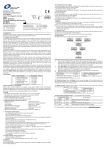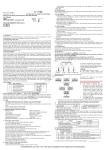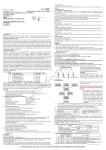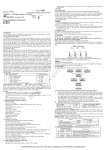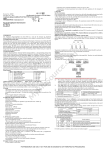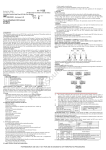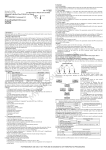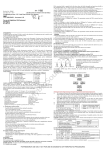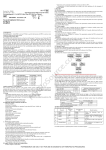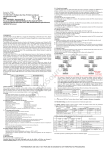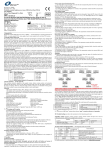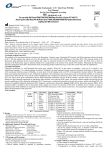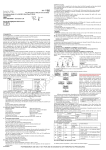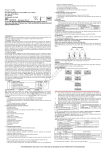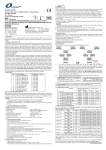Download MBS598132 - MyBioSource
Transcript
For use with LightCycler1.0/2.0 Instrument ※PCR system without 560nm channel may be treated with 1μl Molecular Grade Water instead of 1μl IC. 1) The volumes of Reaction Mix and Enzyme Mix per reaction multiply with the number of samples, which includes the number of controls, standards, and sample prepared. Molecular Grade Water is used as the negative control. For reasons of unprecise pipetting, always add an extra virtual sample. Mix completely then spin down briefly in a centrifuge. 2) Pipet 18μl Master Mix with micropipets of sterile filter tips to each real time PCR reaction plate/tubes. Separately add 2μl DNA sample, positive and negative controls to different reaction plate/tubes. Immediately close the plate/tubes to avoid contamination. 3) Spin down briefly in order to collect the Master Mix in the bottom of the reaction tubes. 4) Perform the following protocol in the instrument: 37°C for 2min 1cycle Selection of fluorescence channels 94°C for 2min 1cycle 530nm Target Nucleic Acid 93°C for 5sec, 60°C for 30sec 560nm IC 40cycles ( Fluorescence measured at 60°C) M yB io So ur 1. Intended Use Rickettsia real time PCR kit is used for the detection of Rickettsia in whole blood (non-anticoagulant) , ticks (fleas,or lice), or tissue samples by using real time PCR systems. 2. Principle of Real-Time PCR The principle of the real-time detection is based on the fluorogenic 5’nuclease assay. During the PCR reaction, the DNA polymerase cleaves the probe at the 5’ end and separates the reporter dye from the quencher dye only when the probe hybridizes to the target DNA. This cleavage results in the fluorescent signal generated by the cleaved reporter dye, which is monitored real-time by the PCR detection system. The PCR cycle at which an increase in the fluorescence signal is detected initially is proportional to the amount of the specific PCR product. Monitoring the fluorescence intensities during real-time allows the detection of the accumulating product without having to re-open the reaction tube after the amplification. 3. Product Description Rickettsia is a genus of non-motile, Gram-negative, non-sporeforming, highly pleomorphic bacteria that can present as cocci (0.1 μm in diameter), rods (1–4 μm long) or thread-like (10 μm long). Rickettsia cannot live in artificial nutrient environments and are grown either in tissue or embryo cultures (typically, chicken embryos are used). The majority of Rickettsia bacteria are susceptible to antibiotics of the tetracycline group. Rickettsia species are carried by many ticks, fleas, and lice, and cause diseases in humans such as typhus, rickettsialpox, Boutonneuse fever, African tick bite fever, Rocky Mountain spotted fever, Flinders Island spotted fever and Queensland tick typhus (Australian Tick Typhus). They have also been associated with a range of plant diseases. The name rickettsia is often used for any member of the Rickettsiales. They are one of closest living relatives to bacteria that were the origin of the mitochondria organelle that exists inside most eukaryotic cells. Rickettsia real time PCR kit contains a specific ready-to-use system for the detection of the Rickettsia by polymerase chain reaction in the real-time PCR system. The master contains reagents and enzymes for the specific amplification of the Rickettsia DNA. Fluorescence is emitted and measured by the real time systems´ optical unit. The detection of amplified Rickettsia DNA fragment is performed in fluorimeter channel FAM. DNA extraction buffer is available in the kit. In addition, the kit contains a system to identify possible PCR inhibition by measuring the 560nm fluorescence of the internal control (IC). 4. Kit Contents Ref. Type of reagent Presentation 25rxns 1 DNA Extraction Buffer 2 vials, 1.5ml 2 Rickettsia Reaction Mix 1 vial, 450μl 4 PCR Enzyme Mix 1 vial, 12μl 5 Molecular Grade Water 1 vial, 400μl 6 Internal Control 1 vial, 30μl 7 Rickettsia Positive Control 1 vial, 30μl 4 Analysis sensitivity: 1×10 copies/ml Note: Analysis sensitivity depends on the sample volume, elution volume, nucleic acid extraction methods and other factors .If you use the DNA extraction buffer in the kit, the analysis sensitivity is the same as it declares. However, when the sample volume is dozens or even hundreds of times greater than elution volume by some concentrating method, it can be much higher. 5. Storage • All reagents should be stored at -20°C. Storage at +4°C is not recommended. • All reagents can be used until the expiration date indicated on the kit label. • Repeated thawing and freezing (> 3x) should be avoided. • Cool all reagents during the working steps. • Super Mix and Reaction Mix should be stored in the dark. 6. Additionally Required Materials and Devices • Biological cabinet • Real time PCR system • Vortex mixer • Real time PCR reaction tubes/plates • Cryo-container • Pipets (0.5μl – 1000μl) • Sterile filter tips for micro pipets • Sterile microtubes • Disposable gloves, powderless • Biohazard waste container • Refrigerator and Freezer • Tube racks • Desktop microcentrifuge for “eppendorf” type tubes (RCF max. 16,000 x g) om MBS598132 - Instrument I, II .c (For Research Use Only In USA & China) Rickettsia Real Time PCR Kit User Manual ce Revision No.: ZJ0002 Issue Date: Jul 1st, 2015 9.1.1 Whole blood or ticks samples 1) Pipet 100μl sample to a 0.5ml tube, add 100μl DNA extraction buffer, close the tube and vortex for 10 seconds. Spin down briefly in a table centrifuge. 2) Incubation the tube for 10 minutes at 100°C. 3) Centrifuge the tube at 13000rpm for 10 minutes. The supernatant contains the DNA extracted and is used for PCR template. 9.1.2 Tissue samples 1) Take 50mg sample to a tube, add 100μl DNA extraction buffer, close the tube then vortex for 10 seconds. Spin down briefly in a table centrifuge. 2) Incubate the tube for 10 minutes at 100°C. 3) Centrifuge the tube at 13000rpm for 10 minutes. The supernatant contains the DNA extracted and can be used for PCR template. Attention: A. During the incubation, make sure the tube is not open, as the vapor will volatilize into the air and may cause contamination in case the sample is positive. B. The extraction sample should be used in 3 hours or stored at -20°C for one month. C. DNA extraction kits are available from various manufacturers. You may use your own extraction systems or the commercial kit based on the yield. For DNA extraction, please comply with the manufacturer’s instructions. 9.2 Internal Control It is necessary to add internal control (IC) in the reaction mix. Internal control (IC) allows the user to determine and control the possibility of PCR inhibition. Add the internal control (IC) 1μl/rxn and the result will be shown in the 560nm. 9.3 PCR Protocol The Master Mix volume for each reaction should be pipetted as follow: 10. Threshold setting: Choose Arithmetic as back ground and none as Noise Band method, then adjust the Noise band just above the maximum level of molecular grade water, and adjust the threshold just under the minimum of the positive control. 11. Quality control: Negative control, positive control correctly, otherwise the sample results is invalid. Channel Control Molecular Grade Water Positive Control(qualitative assay) and internal control must be performed Crossing point value 530nm 560nm Blank 25~35 ≤35 —— 12. Data Analysis and Interpretation :The following results are possible: Crossing point value Result Analysis 530nm 560nm 1# Blank 25~35 Below the detection limit or negative 2# ≤38 Positive; —— 3# 25~35 Re-test; if it is still 38~40, report as 1# 38~40 4# Blank Blank PCR Inhibition; no diagnosis can be concluded. For further questions or problems, please contact our technical support 7. Warnings and Precaution • Carefully read this instruction before starting the procedure. • For in vitro diagnostic use only. • This assay needs to be carried out by skilled personnel. • Clinical samples should be regarded as potentially infectious materials and should be prepared in a laminar flow hood. • This assay needs to be run according to Good Laboratory Practice. • Do not use the kit after its expiration date. • Avoid repeated thawing and freezing of the reagents, this may reduce the sensitivity of the test. • Once the reagents have been thawed, vortex and centrifuge briefly the tubes before use. • Prepare quickly the Reaction mix on ice or in the cooling block. • Set up two separate working areas: 1) Isolation of the RNA/ DNA and 2) Amplification/ detection of amplification products. • Pipets, vials and other working materials should not circulate among working units. • Use always sterile pipette tips with filters. • Wear separate coats and gloves in each area. • Do not pipette by mouth. Do not eat, drink, smoke in laboratory. • Avoid aerosols. 8. Sample Collection, Storage and transport • Collected samples in sterile tubes. • Specimens can be extracted immediately or frozen at -20°C to -80°C. 9. Procedure 9.1 DNA-Extraction DNA extraction buffer is supplied in the kit, please thaw the buffer thoroughly and spin down briefly in the centrifuge before use. FOR RESEARCH USE ONLY. NOT FOR USE IN DIAGNOSTIC OR THERAPEUTIC PROCEDURES. For use with ABI Prism®7000/7300/7500/7900/Step One Plus; iCycler iQ™4/iQ™5; Smart Cycler II;Bio-Rad CFX 96;Rotor Gene™6000; Mx3000P/3005P;MJ-Option2/Chromo4; LightCycler®480 Instrument OR ※PCR system without HEX/VIC/JOE channel may be treated with 1μl Molecular Grade Water instead of 1μl IC. 1) The volumes of Super Mix and Enzyme Mix per reaction multiply with the number of samples, which includes the number of controls and sample prepared. Molecular Grade Water is used as the negative control. For reasons of unprecise pipetting, always add an extra virtual sample. Mix completely then spin down briefly in a centrifuge. 2) Pipet 36μl (22.5μl for SmartCycler II) Master Mix with micropipets of sterile filter tips to each real time PCR reaction plate/tubes. Separately add 4μl (2.5μl for SmartCycler II) DNA sample, positive and negative controls to different reaction plate/tubes. Immediately close the plate/tubes to avoid contamination. 3) Spin down briefly in order to collect the Master Mix in the bottom of the reaction tubes. 4) Perform the following protocol in the instrument: 37°C for 2min 1cycle Selection of fluorescence channels 94°C for 2min 1cycle FAM Target Nucleic Acid 93°C for 15sec, 60°C for 1min HEX/VIC/JOE IC 40cycles ( Fluorescence measured at 60°C) M yB io So ur 1. Intended Use Rickettsia real time PCR kit is used for the detection of Rickettsia in whole blood (non-anticoagulant) , ticks (fleas,or lice), or tissue samples by using real time PCR systems. 2. Principle of Real-Time PCR The principle of the real-time detection is based on the fluorogenic 5’nuclease assay. During the PCR reaction, the DNA polymerase cleaves the probe at the 5’ end and separates the reporter dye from the quencher dye only when the probe hybridizes to the target DNA. This cleavage results in the fluorescent signal generated by the cleaved reporter dye, which is monitored real-time by the PCR detection system. The PCR cycle at which an increase in the fluorescence signal is detected initially is proportional to the amount of the specific PCR product. Monitoring the fluorescence intensities during real-time allows the detection of the accumulating product without having to re-open the reaction tube after the amplification. 3. Product Description Rickettsia is a genus of non-motile, Gram-negative, non-sporeforming, highly pleomorphic bacteria that can present as cocci (0.1 μm in diameter), rods (1–4 μm long) or thread-like (10 μm long). Rickettsia cannot live in artificial nutrient environments and are grown either in tissue or embryo cultures (typically, chicken embryos are used). The majority of Rickettsia bacteria are susceptible to antibiotics of the tetracycline group. Rickettsia species are carried by many ticks, fleas, and lice, and cause diseases in humans such as typhus, rickettsialpox, Boutonneuse fever, African tick bite fever, Rocky Mountain spotted fever, Flinders Island spotted fever and Queensland tick typhus (Australian Tick Typhus). They have also been associated with a range of plant diseases. The name rickettsia is often used for any member of the Rickettsiales. They are one of closest living relatives to bacteria that were the origin of the mitochondria organelle that exists inside most eukaryotic cells. Rickettsia real time PCR kit contains a specific ready-to-use system for the detection of the Rickettsia by polymerase chain reaction in the real-time PCR system. The master contains reagents and enzymes for the specific amplification of the Rickettsia DNA. Fluorescence is emitted and measured by the real time systems´ optical unit. The detection of amplified Rickettsia DNA fragment is performed in fluorimeter channel FAM. DNA extraction buffer is available in the kit. 4. Kit Contents Ref. Type of reagent Presentation 25rxns 1 DNA Extraction Buffer 2 vials, 1.5ml 2 Rickettsia Reaction Mix 1 vial, 950μl 4 PCR Enzyme Mix 1 vial, 12μl 5 Molecular Grade Water 1 vial, 400μl 6 Internal Control 1 vial, 30μl 7 Rickettsia Positive Control 1 vial, 30μl 4 Analysis sensitivity: 1×10 copies/ml Note: Analysis sensitivity depends on the sample volume, elution volume, nucleic acid extraction methods and other factors .If you use the DNA extraction buffer in the kit, the analysis sensitivity is the same as it declares. However, when the sample volume is dozens or even hundreds of times greater than elution volume by some concentrating method, it can be much higher. 5. Storage • All reagents should be stored at -20°C. Storage at +4°C is not recommended. • All reagents can be used until the expiration date indicated on the kit label. • Repeated thawing and freezing (> 3x) should be avoided. • Cool all reagents during the working steps. • Super Mix and Reaction Mix should be stored in the dark. 6. Additionally Required Materials and Devices • Biological cabinet • Real time PCR system • Vortex mixer • Real time PCR reaction tubes/plates • Cryo-container • Pipets (0.5μl – 1000μl) • Sterile filter tips for micro pipets • Sterile microtubes • Disposable gloves, powderless • Biohazard waste container • Refrigerator and Freezer • Tube racks • Desktop microcentrifuge for “eppendorf” type tubes (RCF max. 16,000 x g) om MBS598132 - Instrument III, IV .c (For Research Use Only In USA & China) Rickettsia Real Time PCR Kit User Manual ce Revision No.: ZJ0004 Issue Date: Jul 1st, 2015 9.1.1 Whole blood or ticks samples 1) Pipet 100μl sample to a 0.5ml tube, add 100μl DNA extraction buffer, close the tube and vortex for 10 seconds. Spin down briefly in a table centrifuge. 2) Incubation the tube for 10 minutes at 100°C. 3) Centrifuge the tube at 13000rpm for 10 minutes. The supernatant contains the DNA extracted and is used for PCR template. 9.1.2 Tissue samples 1) Take 50mg sample to a tube, add 100μl DNA extraction buffer, close the tube then vortex for 10 seconds. Spin down briefly in a table centrifuge. 2) Incubate the tube for 10 minutes at 100°C. 3) Centrifuge the tube at 13000rpm for 10 minutes. The supernatant contains the DNA extracted and can be used for PCR template. Attention: A. During the incubation, make sure the tube is not open, as the vapor will volatilize into the air and may cause contamination in case the sample is positive. B. The extraction sample should be used in 3 hours or stored at -20°C for one month. C. DNA extraction kits are available from various manufacturers. You may use your own extraction systems or the commercial kit based on the yield. For DNA extraction, please comply with the manufacturer’s instructions. 9.2 Internal Control It is necessary to add internal control (IC) in the reaction mix. Internal control (IC) allows the user to determine and control the possibility of PCR inhibition. Add the internal control (IC) 1μl/rxn and the result will be shown in the HEX/VIC/JOE. 9.3 PCR Protocol The Master Mix volume for each reaction should be pipetted as follows: 5) If you use ABI Prism® system, please choose “none” as passive reference and quencher. 10. Threshold setting: just above the maximum level of molecular grade water. 11. Quality control: Negative control, positive control and internal control must be performed correctly, otherwise the sample results is invalid. Channel Ct value Control FAM HEX/VIC/JOE Molecular Grade Water UNDET 25~35 Positive Control(qualitative assay) ≤35 —— 12. Data Analysis and Interpretation The following sample results are possible: Ct value Result Analysis FAM HEX/VIC/JOE 1# UNDET 25~35 Below the detection limit or negative 2# ≤38 Positive —— 3# 25~35 Re-test; if it is still 38~40, report as 1# 38~40 4# UNDET UNDET PCR Inhibition; no diagnosis can be concluded. For further questions or problems,please contact our technical support 7. Warnings and Precaution • Carefully read this instruction before starting the procedure. • For in vitro diagnostic use only. • This assay needs to be carried out by skilled personnel. • Clinical samples should be regarded as potentially infectious materials and should be prepared in a laminar flow hood. • This assay needs to be run according to Good Laboratory Practice. • Do not use the kit after its expiration date. • Avoid repeated thawing and freezing of the reagents, this may reduce the sensitivity of the test. • Once the reagents have been thawed, vortex and centrifuge briefly the tubes before use. • Prepare quickly the Reaction mix on ice or in the cooling block. • Set up two separate working areas: 1) Isolation of the RNA/ DNA and 2) Amplification/ detection of amplification products. • Pipets, vials and other working materials should not circulate among working units. • Use always sterile pipette tips with filters. • Wear separate coats and gloves in each area. • Do not pipette by mouth. Do not eat, drink, smoke in laboratory. • Avoid aerosols. 8. Sample Collection, Storage and transport • Collected samples in sterile tubes. • Specimens can be extracted immediately or frozen at -20°C to -80°C. 9. Procedure 9.1 DNA-Extraction DNA extraction buffer is supplied in the kit, please thaw the buffer thoroughly and spin down briefly in the centrifuge before use. FOR RESEARCH USE ONLY. NOT FOR USE IN DIAGNOSTIC OR THERAPEUTIC PROCEDURES.


